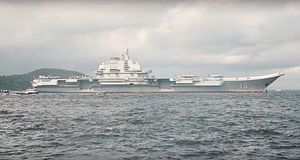The sole operational aircraft carrier of the People’s Liberation Army Navy (PLAN), the 60,000-ton Liaoning, a retrofitted Soviet-era Admiral Kuznetsov-class multirole aircraft carrier, arrived in the former British colony of Hong Kong on July 7. The Liaoning’s visit was part of celebrations held to mark the 20th anniversary of the return of the city to the People’s Republic of China.
The visit is seen as deliberate demonstration of Beijing’s might following statements by Chinese officials that the Sino-British Joint Declaration on Hong Kong, a document signed in 1984 to underpin the peaceful handover of the city, is no longer legally binding. Furthermore, Chinese President Xi Jinping, during his visit to Hong Kong, a quasi self-governing Special Administrative Region, warned pro-democracy activists no to challenge mainland rule.
“Any attempt to endanger China’s sovereignty and security, challenge the power of the central government … or use Hong Kong to carry out infiltration and sabotage activities against the mainland is an act that crosses a red line and is absolutely impermissible,” he said before leaving the city. Xi Jinping also presided over the largest military parade Hong Kong has seen in 20 years.
The Liaoning is making a port call in Hong Kong from July 7 to 11. The ship will be open to the public. Senior Hong Kong government officials, including Chief Executive Carrie Lam and lawmakers, already visited the ship today. According to the Chinese Ministry of Defense, the visit is part of the aircraft carrier’s trans-regional training, which already included “first-degree combat readiness drills.”
The PLAN’s first carrier strike group, which set out from the Chinese port city of Qingdao on June 25, includes the Luyang III-class (Type 052D) guided-missile destroyer Yinchuan , Luyang II-class (Type 052C) guided-missile destroyer Jinan, Jiangkai II-class (Type 054A) guided-missile frigate Yantai, and presumably one to two Yuan-class (Type 039A) or Song-class (Type 039) submarines.
As my colleague Steven Stashwick reported recently, en route to Hong Kong, the Liaoning sailed south through the Taiwan Strait on Sunday, prompting Taiwan to scramble fighter jets and warships to monitor the Chinese carrier strike group. The carrier primarily serves as a training ship and test platform for PLAN carrier-based naval aviation. As I noted in November 2016 (See: “Next Stop South China Sea? China’s 1st Aircraft Carrier ‘Ready for Combat’”):
The Liaoning can accommodate an air wing of 24 Shenyang J-15 multirole fighter jets, a variant of fourth-generation Sukhoi Su-33 twin-engines air superiority fighters, and up to ten rotary wing aircraft including Changshe Z-18, Ka-31, and Harbin Z-9 helicopters. (…) The carrier is fitted with an underpowered aircraft -launching system, a so-called ski-jump assisted Short Take-Off But Arrested Recovery (STOBAR) launch system, for fighter jets aboard the carrier.
Furthermore:
Given the STOBAR system, aircraft launched from the carrier will also have a more limited operational range due to the fact that they need to expend a considerable amount of fuel during take-off in comparison to aircraft launched with a catapult system as is the case in the U.S. Navy.
The Liaoning, commissioned in 2012 and so far not assigned to any of the three major fleets of the PLAN, will not be ready for high-tempo combat operations in the near future for a number of reasons, as I explained elsewhere. However, for the Chinese government the carrier constitutes a potent regional power projection tool, especially in pressing Chinese claims in the South China Sea. The PLAN’s first indigenously designed and developed aircraft carrier, provisionally named Shandong, is expected to enter service in 2020.

































